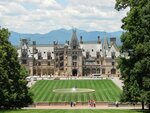The good news is that a new chapter is being written for Lynnewood Hall. The not-as-good news is that it will cost almost $100 million.
This item is available in full to subscribers.
We have recently launched a new and improved website. To continue reading, you will need to either log into your subscriber account, or purchase a new subscription.
If you are a digital subscriber with an active subscription, then you already have an account here. Just reset your password if you've not yet logged in to your account on this new site.
If you are a current print subscriber, you can set up a free website account by clicking here.
Otherwise, click here to view your options for subscribing.
Please log in to continue |






The good news is that a new chapter is now being written for Lynnewood Hall, an architectural relic in Elkins Park. The not-as-good news is that work on the project is slated to cost almost $100 million.
The immense Gilded Age mansion, built for the Widener family, has been acquired by the Lynnewood Hall Preservation Foundation, which is dedicated to its preservation and ongoing management as a cultural center.
But the foundation has a long way to go to reach its goal of restoring the building, its interiors, and the surrounding gardens. So far that group has raised about $9.5 million – a sum that must cover the as-yet undisclosed acquisition costs as well as the initial repairs required to secure the property and keep the water out.
If the new owners are successful, Lynnewood Hall may once again tell a story both about its creation and also of how such relics may be meaningful and useful for future generations.
Built for wealth
The house was built by Peter A.B. Widener, who made his fortune in part by trolley cars. He was one of the savvy, industrious and sometimes lucky entrepreneurs who built great wealth during the years between the Civil War and the early 20th century – competing ruthlessly while forging businesses that brought about a period of unprecedented economic expansion.
Those industrialists then sometimes sought to demonstrate their new-found importance by building private palaces on a scale never before imagined in this country. Widener’s 110-room mansion, including a series of private art galleries, was constructed to the most opulent standards of the day.
His chosen architect, the relatively young Horace Trumbauer, had gotten his start as a 16-year-old apprentice in the offices of the Hewitt Brothers, the favored architects of one of Chestnut Hill’s founding fathers, Henry Howard Houston. By 1890, Trumbauer opened his own architectural office at the precocious age of 21 – without any formal architectural education.
Trumbauer’s big break came when he was hired a few years later by the sugar baron William Welsh Harrison to design Grey Towers Castle (circa 1893) in Glenside, now the home of Acadia University. Then he was commissioned by Widner’s business partner William Elkins to design two mansions in Elkins Park: Chelten House (circa 1896) for Elkin’s son and Elstowe (circa 1898) for himself. Next came Lynnewood Hall, the first phase of which was completed in 1899.
These four houses, each designed in a bombastic Edwardian evocation of a different historical precedent (English Medieval castle, Italian Renaissance palace, Tudor manor house, and English Neo-Palladian mansion), launched his career as a preferred architect of the robber barons of the Gilded Age.
Then, after hiring Julian Abele, the African-American graduate of the architecture department at the University of Pennsylvania and the Ecole des Beaux-Arts in Paris, as chief designer in 1908, the firm went on to create some of that period’s most important buildings, including the now-lost Whitemarsh Hall in Wyndmoor and many other private houses, Widener Memorial Library at Harvard University, Duke University campuses, Philadelphia’s Racquet Club, the 15th Street annex to the Union League, and the Free Library on Logan Circle.
Times changed
But before the elaborate gardens could mature, that privileged world was undermined by the introduction of income taxes, expanding corporate antitrust legislation, the Great Depression, and two terrible world wars. By the middle of the 20th century, those palaces had become dinosaurs, dozing amidst the asteroid showers of change.
Lynnewood Hall passed out of the Widener family in 1952 and has had several institutional owners since. A leaking roof has resulted in some collapsing ceilings, water damage to plasterwork and paneling, dispersal of key interior and garden fittings, and vandalism. Restoration will be a formidable project.
To make matters worse, the house no longer contains the Widener family’s extensive collection of Old Master paintings, furniture and decorative arts. Widener’s only surviving son, Joseph E. Widener, gave some 2,000 works from their collections to the National Gallery in 1939.
There is reason for hope. The modern architectural preservation movement that emerged post-WWII has saved a number of Gilded Age houses, a few of which were in similar states of disrepair. Many have been repurposed for religious or educational activities. The most prominent examples are typically owned by well-managed non-profit organizations, are open to the public on a regular basis, and retain at least some of their original contents and gardens.
Surviving mansions
The remarkable Gilded Age mansions in Newport, Rhode Island, have survived either in private hands or under the careful protection of the Preservation Society of Newport County, which has set the standard for historic properties and offers many lessons for the future of Lynnewood Hall.
Their crown jewel is the Vanderbilt mansion The Breakers. By 1948, the family started leasing the bulk of the house to the Preservation Society and retreated to private apartments on the third floor. Then, in 1972, they sold the house to the Society along with much of its original furniture.
The north shore of Long Island also retains a number of major houses from the period, including the house known as Westbury House at Old Westbury Gardens, which was completed in 1906 for lawyer and businessman John S. Phipps. His father, Henry Phipps, had built the family fortune through the Carnegie Steel Corporation. In 1959, the Phipps descendants created the John L. Phipps Family Foundation to preserve and manage the house with much of its original contents and its famed gardens.
Then there is the Biltmore, near Asheville, North Carolina, another Vanderbilt mansion. That house, much of its original contents and its extensive estate are still owned by Vanderbilt descendants through the Biltmore Company, a family-owned management company. The working estate includes several hotels and rental cottages, a winery and other entertainment options.
Looking farther afield, the current effort to preserve one of the grandest and most troubled of English country houses, Wentworth Woodhouse, is of comparable complexity to Lynnewood Hall – though with 350 rooms is much larger – and offers a good model for its future.
Constructed starting in 1725, it had become uninhabitable by World War II. The house and its extensive outbuildings were occupied by several educational organizations and then went through various private owners until it was acquired in 2017 by the Wentworth Woodhouse Preservation Trust. It was in perilous condition, without the original contents, and the gardens sadly diminished.
Like Lynnewood Hall, Wentworth Woodhouse is located near urban areas. Its trust is striving to optimize that fact with a master plan that calls for “world-class event spaces, overnight accommodation, retail, bar and restaurant attractions, commercial office space and most importantly, a fascinating experience for visitors.” Estimates vary on the costs of that project but are expected to be in excess of $150 million.
Meanwhile, another reclaimed mansion on the other side of our country offers a more cautionary tale.
Carolands, a 98-room, 1916 mansion in the San Francisco suburb of Hillsborough, designed by French architect Ernest Sanson for an heir to the Pullman railway car fortune, went through various periods of decline during the 20th century before businessman Charles B. Johnson bought and restored it as his private residence in 2009.
Three years later, in 2012, Johnson donated the house and grounds to his private foundation at an appraised value of $130 million – and got a $38 million tax break in return. This summer, the journalism non-profit Pro Publica took a close look at that deal – and used it as the subject of an article titled: “How the Ultrawealthy Use Private Foundations to Bank Millions in Tax Deductions While Giving the Public Little in Return.”
For those curious about the future of Lynnewood Hall, visits to these other houses are well worth it (although getting into Carolands may be challenging).
For more information about Lynnewood Hall, go to www.lynnewoodhallpreservation.org.